Your Backyard Wildlife Habitat: Bad Weather Birds, Clear a Space in the Snowstorm
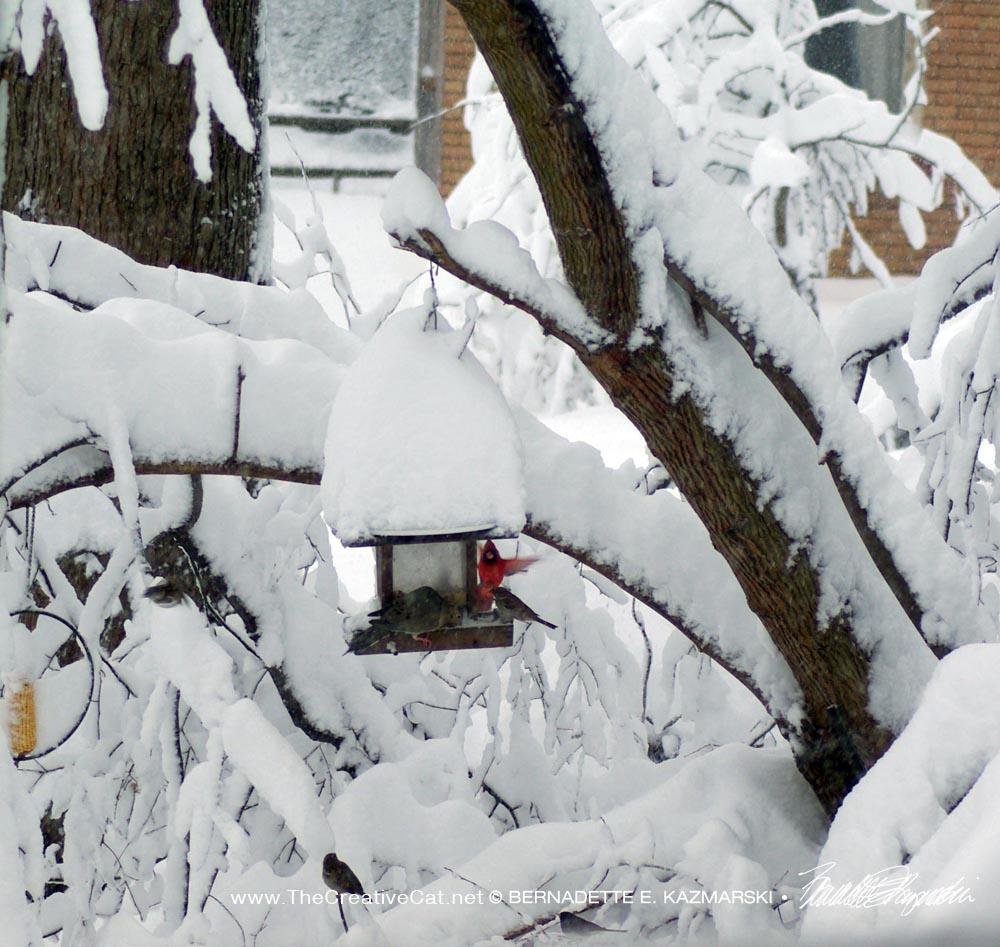
I’D BE REMISS if I didn’t keep Cat TV up and running, even in cold and snowy weather. Not only does birdwatching provide my cats with healthy entertainment and environmental enrichment, it provides it for me too—and welcoming birds to my yard helps in myriad other ways of balancing the habitat and pest control. But when heavy snows fall you should clean off those branches, put out some seed and suet if you can, and don’t forget the all-important water!
. . . . . . .
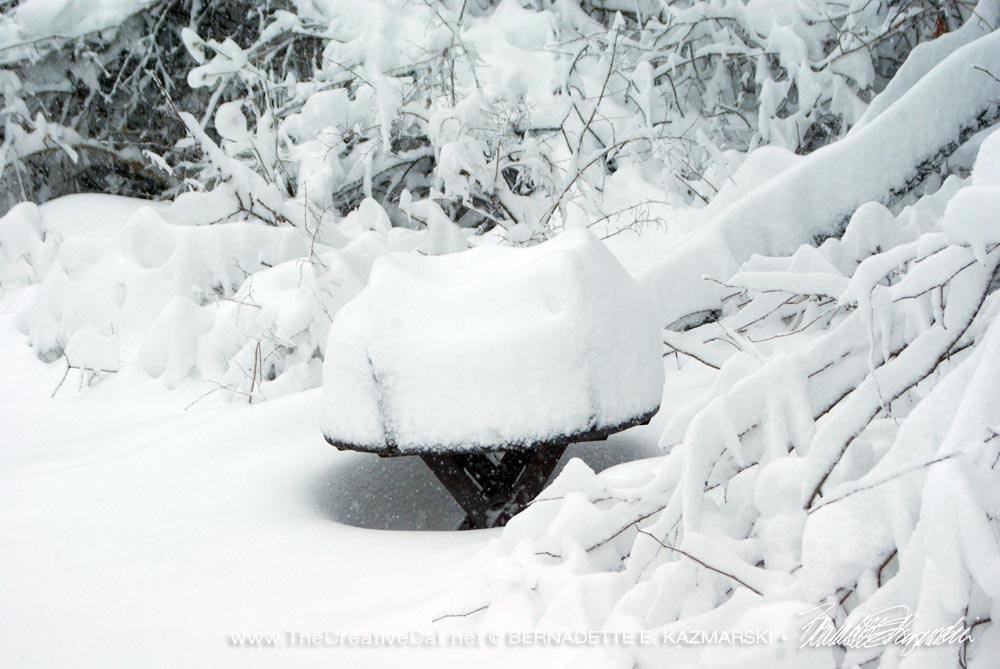
I was entranced overnight as the snow quickly fell and piled on every surface, even tiny twigs. By morning I was ready with my camera, photographing out of windows and emerging on to the deck and porch to capture the rare and magical transformation of a heavily snow-covered morning here in Western Pennsylvania. Shrubs and small trees were bent down and everything, my brush piles and tall native plants left in the habitat included, was covered with an undulating snow blanket at least 18 inches deep.
Doves were lined up on the clothes line on my deck and wrens and sparrows were perching under the rockers and other chairs, using my deck for cover and no doubt waiting for me to put out the goodies.
However, as I cleaned off the deck and filled the feeders around the railings and the improvised bird bath I saw flocks of birds headed for both the deck and at least one of the feeders at the end of the yard (the other was hopelessly covered by its small tree completely bent over under the weight of snow), but they weren’t using the feeder and they weren’t perching, which was very strange behavior.
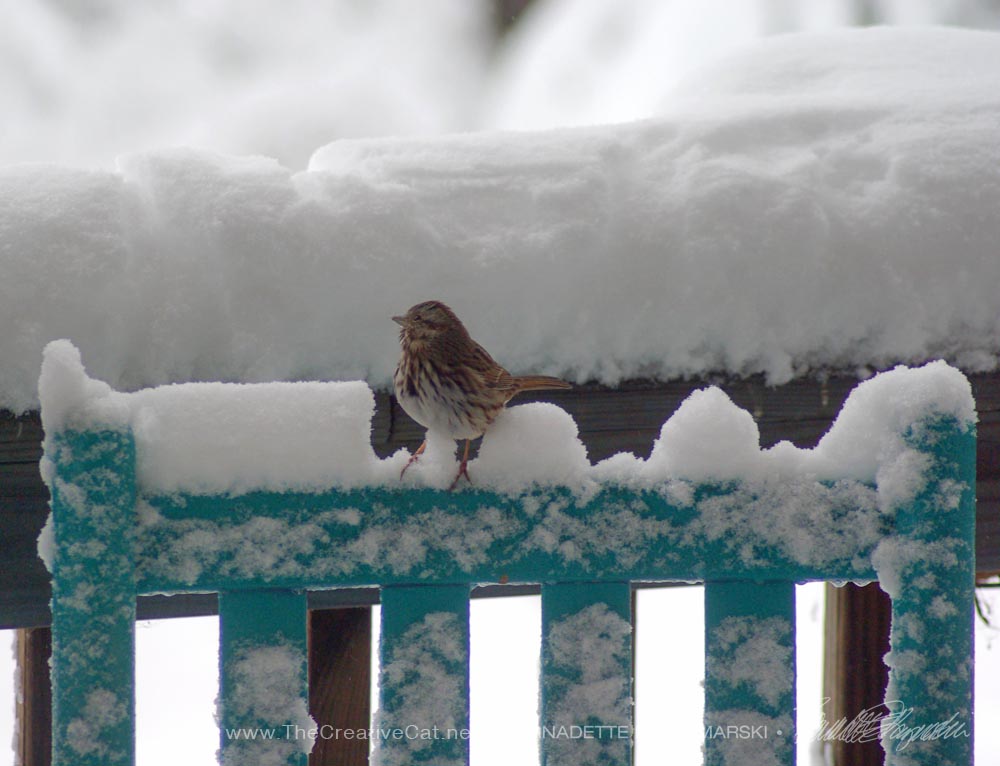
I had filled the seed and suet feeders and put out some ear corn the prior afternoon so they would have it first thing in the morning instead of waiting for me to dig out. If the Cooper’s hawk had been around I wouldn’t have seen any birds at all, except perhaps a sacrificial mourning dove.
Then I took another look at this lovely landscape—the forsythia which is usually filled with sparrows, the pussy willow hosting the larger cardinals and blue jays, even the American Hemlock and brushy saplings around the larger feeder on which and in which the birds are usually perching in wait for the feeders, were all covered with several inches of snow which the birds couldn’t perch on. All the tall stems of goldenrod, asters, coneflower and bee balm that I leave standing for the birds to use as both perches and food sources were completely bent down and covered in snow. Even the ground around the feeders was covered with snow the birds couldn’t land on top of without dangerously sinking in.
They had no place to land and nothing to eat.
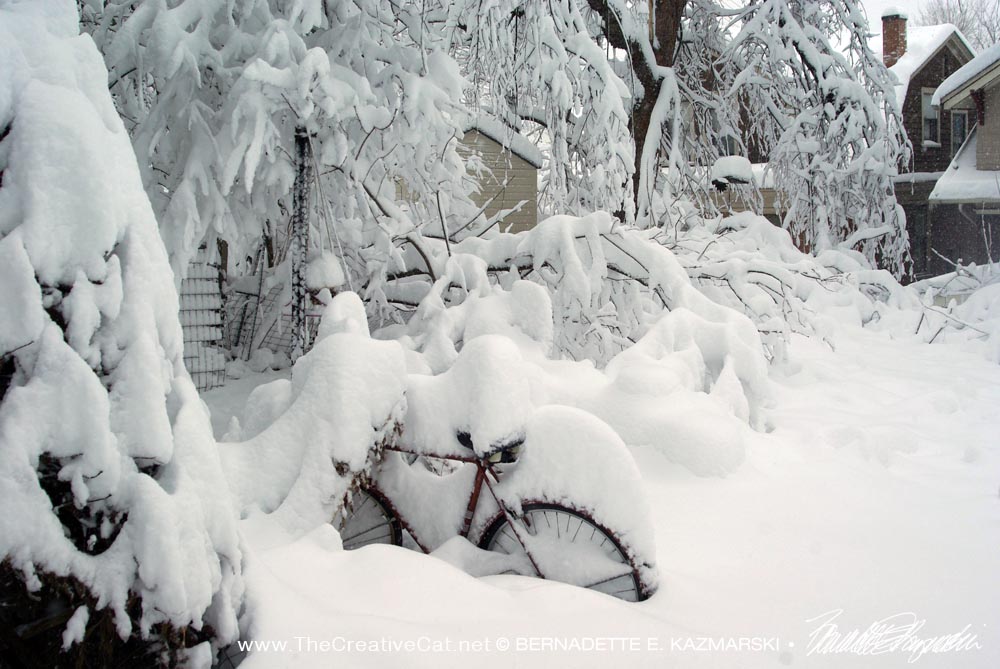
This was a totally different interpretation of a lovely snowy morning, and potentially fatal to all my avian visitors. Where smaller mammals can and do tunnel under the snow and larger ones travel over it or can walk through it, birds can’t brush away snow and ice before they land or dig through it to get to something underneath. In order to use the feeder they need to land close, then hop to the feeder. Unless they could land right on the feeder, they couldn’t eat from it, and all their natural sources were under snow, not only in my yard but everywhere.

Well, I’d probably gotten as many photos as I wanted, so out came the broom and I waded in snow that had drifted deeper than the 18 inches I had measured earlier and swatted away at the forsythia, pulling the longer branches out of the snow on the ground so they could swing free. Then I reached the pussy willow from the deck railing on one side, and the lilac from the other side. As I was working a large clump of snow fell from higher up in the trees at the end of the yard and conveniently knocked the snow off of the feeder in the yard as well as the hemlock and saplings. Thanks, nature!
Help your birds in heavy snow
I first published this during the 2010 Snowmageddon and all photos are from February 2010; deep, heavy snows like that are happening more and more often so it’s good to be aware and prepared when you need to dig your birds out as well as yourself.
Even if you don’t have a heavy snowfall, though, snow and ice hamper the ability to forage for any wild creature, but birds have it especially difficult. Heavy snow layers branches and fills the shrubs and brushy areas they use for cover, their little feet can be caught up in ice and landing on the ground just isn’t safe. They can quickly become exhausted just trying to find a place to perch, and if all their food sources are covered by heavy snow their little lives are actually in danger. Birds need to balance filling their bellies with their ability to fly, so “eating like a bird” entails eating just enough, and eating constantly, so they don’t weigh their little bodies down.
Here are a few things you can do for your backyard visitors once you get yourself shoveled out.
Clean the snow out of shrubs used for cover
I was barely finished with clearing one bush and then the other before the birds were in it, chattering and fluttering. And even though they are familiar with me—the blue jay had announced that I had come out onto the deck earlier, and that’s the signal for birds to gather in the shrubs around the deck anticipating the daily feeder refill—they don’t usually fly right past my head to get to the feeders, but today they did.
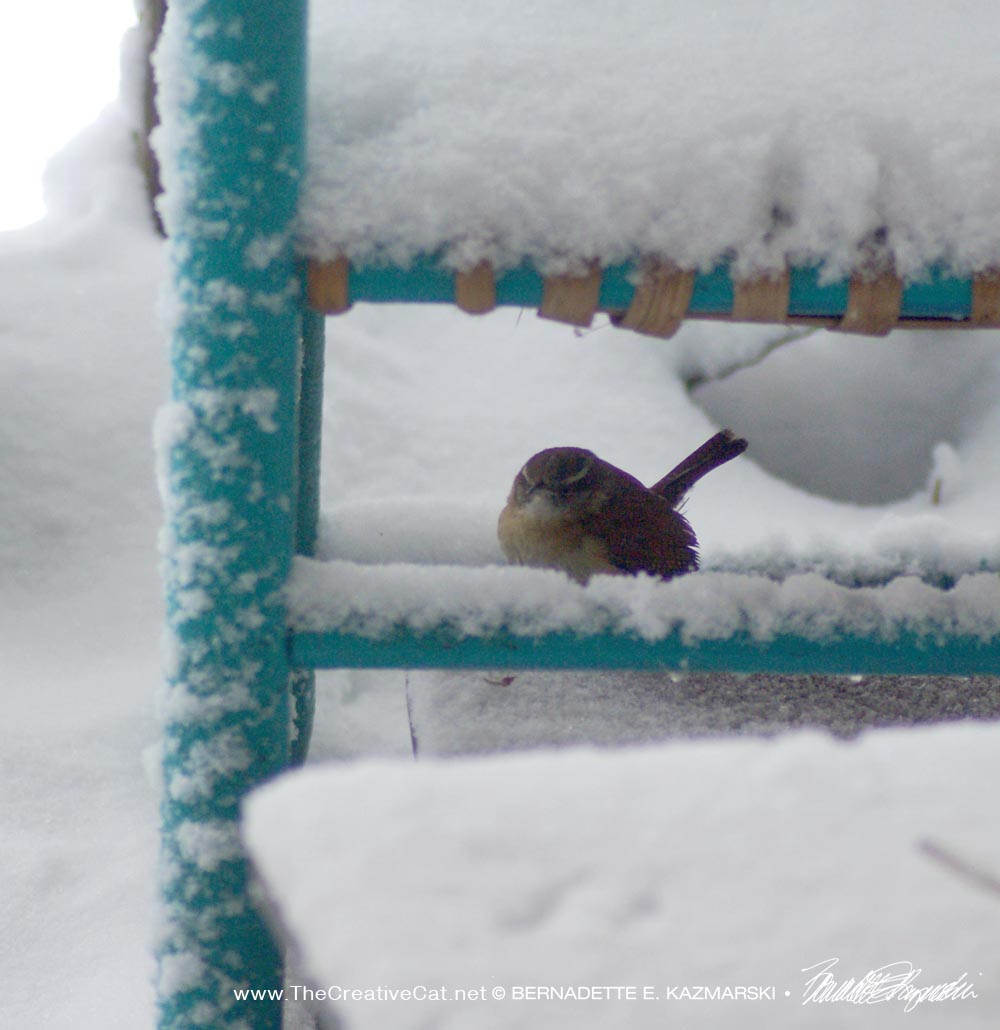
“Eating like a bird” has been famously misinterpreted indicating a picky eater, but while birds don’t all eat twice their weight in food every day, they do need to eat proportionally much more than humans, especially in cold weather. Imagine having to hop out of bed into a situation you physically can’t negotiate and having to forage for enough quality food to equal about a quarter to a half of your body weight just stay warm and alive for the day and overnight, using only your face and toes as tools.
Temperatures have been in the single digits and even below zero, and some birds would simply die overnight if they hadn’t been able to find or access any food during the day. Out in nature, nobody would brush off the trees and fill the feeders, but with songbird populations imperiled because of habitat fragmentation and pesticide use, they could use a little help from us.
High energy food
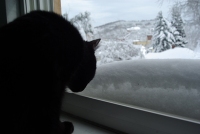
If you do feed birds, put out some extra stuff, especially high-protein, high-energy foods like hulled sunflower, peanuts and even other unsalted or plain nuts you might have on hand; I donated a cup of crushed walnuts, which were a really big hit. Dried fruits are very good for them now, too, even just a handful of raisins snipped in half so smaller birds can manage them. Many birds eat insects as well as seeds, and suet fills that part of their diet when no insects are available. The extra protein will help them get through a cold night and into tomorrow.
All-important water
Don’t forget the water—just a shallow pan of warm water will keep from freezing most of the day and be easy to punch out and refill in the morning. I use anything from the plastic plates used under hard rubber planters to takeout containers, square, round, rectangular, birds don’t care. In this case, below, the actual container for the water is a little lightweight, so I have it inside another container.
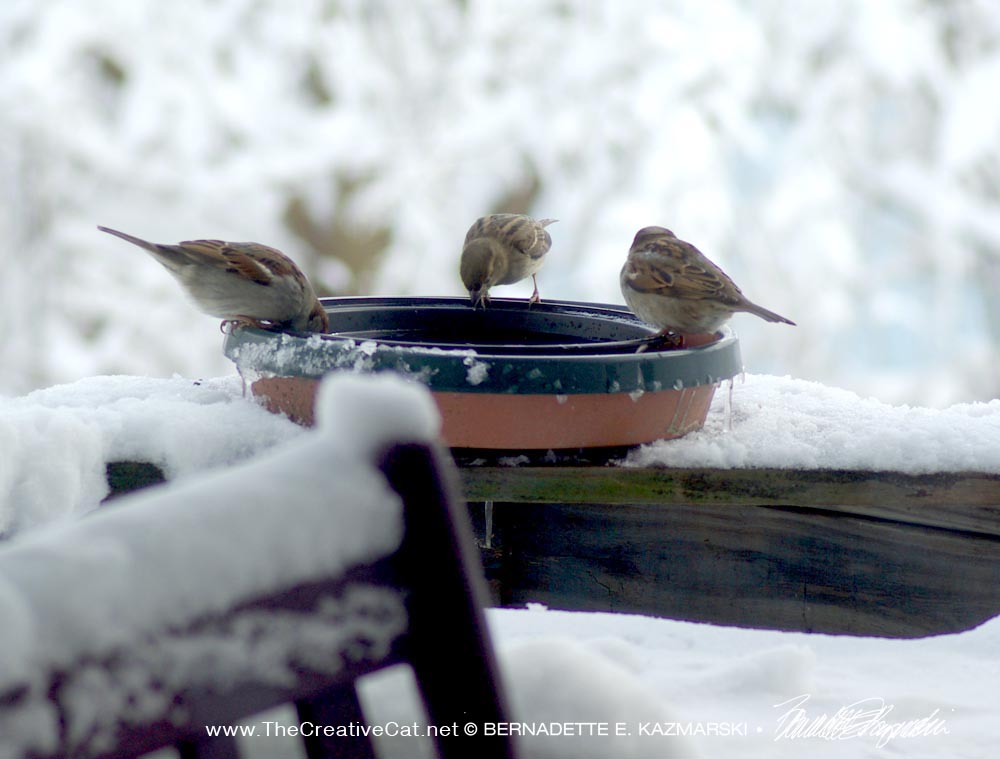
Rising steam from warm water will help attract them to it, but getting them to notice a water source—in any weather—is tricky. In this case the corner of the deck railing was a place they landed to visit the feeders and being naturally curious the chickadees found it first, then told all the other birds about it. It’s best for the water to be moving somehow, either with a little pump or bubbler in it, but I’ve also rigged up a gallon jug with holes punched in it that I hung above a bird bath so that it would drip into the still water below for several hours. Once the birds find it, they will visit it forever, even when it’s empty.
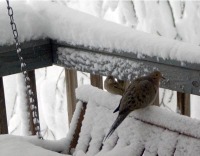
If you don’t normally feed birds it’s highly unlikely you’d be able to attract them to a new feeder or water source today. But at least knock the snow off of any shrubs with twigs small enough for bird claws to grasp, and especially from any dense shrubs they would normally use for cover. Birds roost overnight in tree cavities and in other protected places, usually huddled together for extra warmth. While snow is a great insulator the snowfall we had that February was really unique in that snow was piled on branches where I’ve never seen it, on the lee side of trees, and some shrubs like the forsythia were completely filled with snow, leaving the most typical spots for avian protection unavailable. A number of birds took shelter on my deck for a couple of days.
Other ways to help your birds
I have articles on making your own inexpensive bird treats in Birds?! Attract them with homemade suet cakes and my series of articles on Backyard Wildlife Habitats provides more information on inviting and feeding wild birds and other wildlife in your backyard.
Backyard Wildlife Habitats
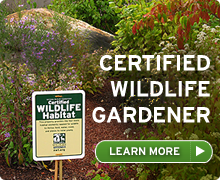
My backyard wildlife habitat was certified through National Wildlife Federation’s program in 2003, and their site is still one of my favorite references for information. Visit and read about it, and begin planning your own and be certified!
. . . . . . .
Read the entire series of introductory articles:
An Introduction to Backyard Wildlife Habitats
What’s in Your Backyard? The First Step in Planning Your Backyard Wildlife Habitat
What Else is in Your Backyard: The Fauna That Fill It
Bringing it All Together: Enhancing and Developing Your Habitat
. . . . . . .
Also read about my art, photography, poetry and prose inspired by my backyard wildlife habitat:
Art Inspired by My Backyard Wildlife Habitat
Photography Inspired by My Backyard Wildlife Habitat
Poetry Inspired by My Backyard Wildlife Habitat
Prose Inspired by My Backyard Wildlife Habitat
Or just read other articles in the category of Your Backyard Wildlife Habitat
Art and Gifts featuring cats you know! Visit Portraits of Animals
Wildlife Artwork from Portraits of Animals!
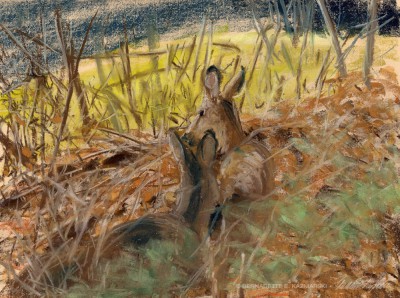
Though they were in plain sight of about six houses and all of us watched them, they apparently felt they were safe—and they were, really, because when I looked at the reference photo for this I wondered why I’d taken a photo of the brush at the end of the yard, and then I saw the ears. It was the perfect cover, hidden in plain sight.

Copyright
All images and text used on this site are copyrighted to Bernadette E. Kazmarski unless otherwise noted and may not be used without my written permission, although links to your site are more than welcome and are shared. Please ask if you are interested in using and image or story in a print or internet publication. If you are interested in purchasing a print of an image or a product including it, check my animal and nature website Portraits of Animals to see if I have it available already. If you don’t find it there, visit Ordering Custom Artwork for more information on a custom greeting card, print or other item.
Subscribe to my e-newsletter
Subscribe to The Creative Cat Preview E-newsletter.
© 2022 | www.TheCreativeCat.net | Published by Bernadette E. Kazmarski
Weekly schedule of features:
Sunday: Essays, Pet Loss, Poetry, The Artist’s Life
Monday: Adoptable Cats, TNR & Shelters
Tuesday: Rescue Stories
Wednesday: Commissioned Portrait or Featured Artwork
Thursday: New Merchandise
Friday: Book Review, Health and Welfare, Advocacy
Saturday: Your Backyard Wildlife Habitat, Living Green With Pets, Creating With Cats
And sometimes, I just throw my hands in the air and have fun!




Pingback: Your Backyard Wildlife Habitat: Clear Away the Snow for Bad Weather Birds ~ The Creative Cat